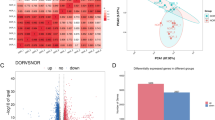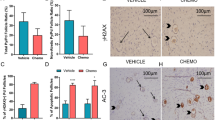Abstract
Diminished ovarian reserve (DOR) is an etiologically heterogeneous disorder that usually leads to poor reproductive outcomes. Does a specific or common pathogenesis exist for DOR subtypes with different etiologies? Two frequently used mouse models, age-related DOR (AR-DOR) and cyclophosphamide (CTX)-induced DOR (CTX-DOR), were successfully established, and RNA sequencing was performed on ovarian tissue samples. Differentially expressed genes (DEGs) in each subtype and common DEGs (co-DEGs) in the two subtypes were identified. Subsequently, we performed comprehensive bioinformatics analyses, including an evaluation of immune cell infiltration. Finally, the genes of interest were further validated by performing RT-qPCR and immunohistochemistry. In AR-DOR mice, functional enrichment analyses showed that upregulated DEGs were mainly involved in the inflammatory/immune response, while downregulated DEGs were involved in DNA damage repair. In CTX-DOR mice, the inflammatory/immune response and cell apoptosis played significant roles. Meanwhile, 406 co-DEGs were identified from the two models. The biological functions of these co-DEGs were associated with inflammatory/immune responses. The analysis of immune cell infiltration showed reduced infiltration of Treg cells, as well as increased infiltration of M0 macrophages, NK resting, and T cells CD4 follicular in both DOR subtypes. The results of the validation experiments were consistent with the RNA sequencing data. In conclusion, the inflammatory/immune response might be the common pathogenesis for the two DOR subtypes, while DNA repair and cell apoptosis may have different roles in the two subtypes. These results may provide potential insights for mechanistic research and therapeutic targets of DOR.







Similar content being viewed by others
Data Availability
Not applicable.
References
Testing and interpreting measures of ovarian reserve. a committee opinion. Fertil Steril. 2015;103(3):e9–17. https://doi.org/10.1016/j.fertnstert.2014.12.093.
Fàbregues F, Ferreri J, Méndez M, et al. In vitro follicular activation and stem cell therapy as a novel treatment strategies in diminished ovarian reserve and primary ovarian insufficiency. Front Endocrinol (Lausanne). 2020;11:617704. https://doi.org/10.3389/fendo.2020.617704.
Jiao Z, Bukulmez O. Potential roles of experimental reproductive technologies in infertile women with diminished ovarian reserve. J Assist Reprod Genet. 2021;38(10):2507–17. https://doi.org/10.1007/s10815-021-02246-6.
Levi AJ, Raynault MF, Bergh PA, et al. Reproductive outcome in patients with diminished ovarian reserve. Fertil Steril. 2001;76(4):666–9.
Christodoulaki A, Boel A, Tang M, et al. Prospects of germline nuclear transfer in women with diminished ovarian reserve. Frontiers in Endocrinology. 2021;12:635370. https://doi.org/10.3389/fendo.2021.635370.
Pastore LM, Christianson MS, Stelling J, et al. Reproductive ovarian testing and the alphabet soup of diagnoses: DOR, POI, POF, POR, and FOR. J Assist Reprod Genet. 2018;35(1):17–23. https://doi.org/10.1007/s10815-017-1058-4.
Liu H, Jiang C, La B, et al. Human amnion-derived mesenchymal stem cells improved the reproductive function of age-related diminished ovarian reserve in mice through Ampk/FoxO3a signaling pathway. Stem Cell Res & Therapy. 2021;12(1):317. https://doi.org/10.1186/s13287-021-02382-x.
Huang P, Zhou Y, Tang W, et al. Long-term treatment of Nicotinamide mononucleotide improved age-related diminished ovary reserve through enhancing the mitophagy level of granuloas cells in mice. J Nutr Biochem. 2022;101:108911. https://doi.org/10.1016/j.jnutbio.2021.108911.
Jiang L, Chen Y, Wang Q, et al. A Chinese practice guideline of the assisted reproductive technology strategies for women with advanced age. J Evid Based Med. 2019;12(2):167–84. https://doi.org/10.1111/jebm.12346.
Park SU. L Walsh, and K M Berkowitz, Mechanisms of ovarian aging. Reproduction. 2021;162(2):R19–33. https://doi.org/10.1530/REP-21-0022.
te Velde ER, Pearson PL. The variability of female reproductive ageing. Hum Reprod Update. 2002;8(2):141–54.
Kim S, Kim S-W, Han S-J, et al. Molecular mechanism and prevention strategy of chemotherapy- and radiotherapy-induced ovarian damage. Int J Mol Sci. 2021;22(14):7484. https://doi.org/10.3390/ijms22147484
Hopeman MM, Cameron KE, Prewitt M, et al. A predictive model for chemotherapy-related diminished ovarian reserve in reproductive-age women. Fertil Steril. 2021;115(2):431–7. https://doi.org/10.1016/j.fertnstert.2020.08.003.
Spears N, Lopes F, Stefansdottir A, et al. Ovarian damage from chemotherapy and current approaches to its protection. Hum Reprod Update. 2019;25(6):673–93. https://doi.org/10.1093/humupd/dmz027.
Li J, Yu Q, Huang H, et al. Human chorionic plate-derived mesenchymal stem cells transplantation restores ovarian function in a chemotherapy-induced mouse model of premature ovarian failure. Stem Cell Res Ther. 2018;9(1):81. https://doi.org/10.1186/s13287-018-0819-z.
Qin X, Zhao Y, Zhang T, et al. TrkB agonist antibody ameliorates fertility deficits in aged and cyclophosphamide-induced premature ovarian failure model mice. Nat Commun. 2022;13(1):914. https://doi.org/10.1038/s41467-022-28611-2.
Sun M, Wang S, Li Y, et al. Adipose-derived stem cells improved mouse ovary function after chemotherapy-induced ovary failure. Stem Cell Res Ther. 2013;4(4):80. https://doi.org/10.1186/scrt231.
Yureneva S, Averkova V, Silachev D, et al. Searching for female reproductive aging and longevity biomarkers. Aging. 2021;13(12):16873–94. https://doi.org/10.18632/aging.203206.
Peterson CL, Côté J. Cellular machineries for chromosomal DNA repair. Genes Dev. 2004;18(6):602–16. https://doi.org/10.1101/gad.1182704.
Schneider A, Matkovich SJ, Saccon T, et al. Ovarian transcriptome associated with reproductive senescence in the long-living Ames dwarf mice. Mol Cell Endocrinol. 2017;439:328–36. https://doi.org/10.1016/j.mce.2016.09.019.
Beverley R. M L Snook, and M A Brieño-Enríquez, Meiotic cohesin and variants associated with human reproductive aging and disease. Front Cell Dev Biol. 2021;9:710033. https://doi.org/10.3389/fcell.2021.710033.
Oktay K, Turan V, Titus S, et al. BRCA mutations, DNA repair deficiency, and ovarian aging. Biol Reprod. 2015;93(3):67. https://doi.org/10.1095/biolreprod.115.132290.
Titus S, Li F, Stobezki R, et al. Impairment of BRCA1-related DNA double-strand break repair leads to ovarian aging in mice and humans. Sci Transl Med. 2013;5(172):17221. https://doi.org/10.1126/scitranslmed.3004925.
Govindaraj V. R Keralapura Basavaraju, and A J Rao, Changes in the expression of DNA double strand break repair genes in primordial follicles from immature and aged rats. Reprod Biomed Online. 2015;30(3):303–10. https://doi.org/10.1016/j.rbmo.2014.11.010.
Govindaraj V, Krishnagiri H, Chakraborty P, et al. Age-related changes in gene expression patterns of immature and aged rat primordial follicles. Syst Biol Reprod Med. 2017;63(1):37–48. https://doi.org/10.1080/19396368.2016.1267820.
Taniguchi T, D’Andrea AD. Molecular pathogenesis of Fanconi anemia: recent progress. Blood. 2006;107(11):4223–33. https://doi.org/10.1182/blood-2005-10-4240.
Sklavos MM, Giri N, Stratton P, et al. Anti-Müllerian hormone deficiency in females with Fanconi anemia. J Clin Endocrinol Metab. 2014;99(5):1608–14. https://doi.org/10.1210/jc.2013-3559.
Piasecka-Srader J, Blanco FF, Delman DH, et al. Tamoxifen prevents apoptosis and follicle loss from cyclophosphamide in cultured rat ovaries. Biol Reprod. 2015;92(5):132. https://doi.org/10.1095/biolreprod.114.126136.
Pascuali N, Scotti L, Di Pietro M, et al. Ceramide-1-phosphate has protective properties against cyclophosphamide-induced ovarian damage in a mice model of premature ovarian failure. Hum Reprod. 2018;33(5):844–59. https://doi.org/10.1093/humrep/dey045.
Yuksel A, Bildik G, Senbabaoglu F, et al. The magnitude of gonadotoxicity of chemotherapy drugs on ovarian follicles and granulosa cells varies depending upon the category of the drugs and the type of granulosa cells. Hum Reprod. 2015;30(12):2926–35. https://doi.org/10.1093/humrep/dev256.
Zhao Z, Fan Q, Zhu Q, et al. Decreased fatty acids induced granulosa cell apoptosis in patients with diminished ovarian reserve. J Assist Reprod Genet. 2022;39(5):1105–14. https://doi.org/10.1007/s10815-022-02462-8.
D’Avila ÂM, Biolchi V, Capp E, et al. Age, anti-müllerian hormone, antral follicles count to predict amenorrhea or oligomenorrhea after chemotherapy with cyclophosphamide. J Ovarian Res. 2015;8:82. https://doi.org/10.1186/s13048-015-0209-4.
Lande Y, Fisch B, Tsur A, et al. Short-term exposure of human ovarian follicles to cyclophosphamide metabolites seems to promote follicular activation in vitro. Reprod Biomed Online. 2017;34(1):104–14. https://doi.org/10.1016/j.rbmo.2016.10.005.
Deng T, He J, Yao Q, et al. Human umbilical cord mesenchymal stem cells improve ovarian function in chemotherapy-induced premature ovarian failure mice through inhibiting apoptosis and inflammation via a paracrine mechanism. Reprod Sci. 2021;28(6):1718–32. https://doi.org/10.1007/s43032-021-00499-1.
Bukovsky A, Presl J. Ovarian function and the immune system. Med Hypotheses. 1979;5(4):415–36. https://doi.org/10.1016/0306-9877(79)90108-7.
Nishizuka Y, Sakakura T. Thymus and reproduction: sex-linked dysgenesia of the gonad after neonatal thymectomy in mice. Science. 1969;166(3906):753–5.
Lliberos C, Liew SH, Zareie P, et al. Evaluation of inflammation and follicle depletion during ovarian ageing in mice. Sci Rep. 2021;11(1):278. https://doi.org/10.1038/s41598-020-79488-4.
Lliberos C, Liew SH, Mansell A, et al. The inflammasome contributes to depletion of the ovarian reserve during aging in mice. Front Cell Dev Biol. 2020;8:628473. https://doi.org/10.3389/fcell.2020.628473.
Luo Q, Yin N, Zhang L, et al. Role of SDF-1/CXCR4 and cytokines in the development of ovary injury in chemotherapy drug induced premature ovarian failure mice. Life Sci. 2017;179:103–9. https://doi.org/10.1016/j.lfs.2017.05.001.
Du Y, Carranza Z, Luan Y, et al. Evidence of cancer therapy-induced chronic inflammation in the ovary across multiple species: a potential cause of persistent tissue damage and follicle depletion. J Reprod Immunol. 2022;150:103491. https://doi.org/10.1016/j.jri.2022.103491.
Aoki N, Kimura S, **ng Z. Role of DAP12 in innate and adaptive immune responses. Curr Pharm Des. 2003;9(1):7–10. https://doi.org/10.2174/1381612033392503
Mukherjee S, Klaus C, Pricop-Jeckstadt M, et al. A microglial signature directing human aging and neurodegeneration-related gene networks. Front Neurosci. 2019;13:2. https://doi.org/10.3389/fnins.2019.00002.
Alessandrini F, Pezzè L, Ciribilli Y. LAMPs: Shedding light on cancer biology. Semin Oncol. 2017;44(4):239–53. https://doi.org/10.1053/j.seminoncol.2017.10.013.
Liu Y, Masternak MM, Schneider A, et al. Dwarf mice as models for reproductive ageing research. Reprod Biomed Online. 2022;44(1):5. https://doi.org/10.1016/j.rbmo.2021.09.016.
Saccon TD, Rovani MT, Garcia DN, et al. Growth hormone increases DNA damage in ovarian follicles and macrophage infiltration in the ovaries. Geroscience. 2021. https://doi.org/10.1007/s11357-021-00380-8.
Yang Z, Tang Z, Cao X, et al. Controlling chronic low-grade inflammation to improve follicle development and survival. Am J Reprod Immunol. 2020;84(2):e13265. https://doi.org/10.1111/aji.13265.
Huang Y, Hu C, Ye H, et al. Inflamm-aging: a new mechanism affecting premature ovarian insufficiency. J Immunol Res. 2019;2019:8069898. https://doi.org/10.1155/2019/8069898.
Jiao X, Zhang X, Li N, et al. T deficiency-mediated T 1 response causes human premature ovarian insufficiency through apoptosis and steroidogenesis dysfunction of granulosa cells. Clin Transl Med. 2021;11(6):e448. https://doi.org/10.1002/ctm2.448.
Gu X. S-Y Li, and T DeFalco, Immune and vascular contributions to organogenesis of the testis and ovary. FEBS J. 2022;289(9):2386–408. https://doi.org/10.1111/febs.15848.
Zhang Z. L Huang, and L Brayboy, Macrophages: an indispensable piece of ovarian health. Biol Reprod. 2021;104(3):527–38. https://doi.org/10.1093/biolre/ioaa219.
Ordaz-Arias MA, Díaz-Alvarez L, Zúñiga J, et al. Cyclic attractors are critical for macrophage differentiation, heterogeneity, and plasticity. Front Mol Biosci. 2022;9:807228. https://doi.org/10.3389/fmolb.2022.807228.
Funding
This work was supported by the National Natural Science Foundation of China (No. 81960278), the Outstanding Youth Funds of Science and Technology Department of Gansu Province (No. 20JR5RA371), the Key Research and Development Program of Gansu Province (No. 20YF3FA031), and Longyuan Youth Innovation and Entrepreneurship Talent Project.
Author information
Authors and Affiliations
Contributions
Ruifen He, **aolei Liang, and Yongxiu Yang contributed to the central idea and design of work; Qigang Fan, Yi Li, and Qinying Zhu, acquisition of sample and sample processing; Ruifen He, Dan Hu, Junhong Du, and Yijuan **ng, analysis and interpretation of data; Hongli Li, **aolei Liang, and Yongxiu Yang, critical feedback of the manuscript. The original draft was written by Ruifen He.
Corresponding authors
Ethics declarations
Ethics Approval
This study makes the use of male C57BL/6 mice, and all the experimental protocol for the use of animal was approved by the Ethics Committee of the First Hospital of Lanzhou University (LDYYLL2019-44).
Consent to Participate
Not applicable.
Consent for Publication
All the co-authors have agreed to publication in the journal.
Competing Interests
The authors declare no competing interests.
Additional information
Publisher's Note
Springer Nature remains neutral with regard to jurisdictional claims in published maps and institutional affiliations.
Supplementary Information
Below is the link to the electronic supplementary material.
Rights and permissions
Springer Nature or its licensor (e.g. a society or other partner) holds exclusive rights to this article under a publishing agreement with the author(s) or other rightsholder(s); author self-archiving of the accepted manuscript version of this article is solely governed by the terms of such publishing agreement and applicable law.
About this article
Cite this article
He, R., Fan, Q., Li, Y. et al. Identification of Common and Specific Genes Involved in Mouse Models of Age-Related and Cyclophosphamide-Induced Diminished Ovarian Reserve. Reprod. Sci. 30, 1965–1978 (2023). https://doi.org/10.1007/s43032-022-01161-0
Received:
Accepted:
Published:
Issue Date:
DOI: https://doi.org/10.1007/s43032-022-01161-0




